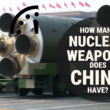Learning from nuclear accidents, expanding nuclear energy
By Augustin Simo, April 26, 2016
Nuclear energy accounts for about 11 percent of world electricity production, and this share is likely to increase over the medium term as the world seeks to limit carbon dioxide in the atmosphere and thereby mitigate climate change. But since the Fukushima accident, global expansion of nuclear energy has slowed—just as it did after the Chernobyl disaster. Accidents at power reactors, even when their severity is limited, can create in the public an unjustified phobia about nuclear energy.
The Chernobyl disaster of 1986 was caused by factors including a flawed reactor design, insufficient training of plant operators, and a lack of nuclear safety culture. About 30 people died soon after the explosion as a consequence of acute radiation syndrome, and the death toll has since risen to 56 or so. Any premature death is regrettable. But Chernobyl mobilized scientists and engineers to improve electronic control of reactor operations. It led to improved instruction in nuclear safety culture. The probability of another accident similar to Chernobyl now appears very low.
The world's second major nuclear accident, 25 years after the first, was the Fukushima disaster of five years ago. In this case the cause was external events—a high-magnitude earthquake and tsunami. No deaths related to radiation were reported, though quite a few deaths can be attributed to anxiety or other psychological effects. Of the 160,000 people who were displaced from the accident area, about 60,000 have returned to their homes and others are returning slowly.
The global nuclear community is still learning the lessons of Fukushima. But it is already using those lessons to prevent future accidents. When new power plants are designed, severe external hazards are now being taken into account. Substitutes are being developed for components that failed at Fukushima. Mobile systems have been developed to provide electricity or cooling water to power plants when their own systems fail. Many countries have subjected their nuclear power installations to stress tests, and many have reviewed their legal and safety frameworks. Under the leadership of the International Atomic Energy Agency (IAEA), international safety standards have been strengthened. Networks of regulators, operators, and vendors have been established at the international, regional, and sub-regional levels to enhance the global nuclear safety regime. International conferences have been organized with a focus on understanding the origins and harmful effects of the Fukushima accident. As a result, nuclear power plants around the world are receiving improved guidance for strengthening their safety measures.
So both the Chernobyl and Fukushima accidents have provided lessons that are improving nuclear safety. And the international nuclear community is making consistent, effective efforts to avert loss of human life (even though it is impossible to exclude that possibility in the event of a severe nuclear accident). Yet space exists for further improvement. International cooperation among nuclear power plant operators should be enhanced. More nations should participate in the international peer reviews of nuclear installations that the IAEA's board of governors recommended in a 2011 action plan. These missions are a good step toward enhancing safety culture and winning public acceptance of nuclear energy—and toward improving emergency preparedness and response.
Global harmonization. Indeed, where preparedness and response for nuclear and radiological accidents are concerned, the IAEA has already developed specific safety standards. But there is still a need to harmonize approaches to emergency preparedness and response around the world. Each country, whether it uses nuclear power or not, should continuously develop and maintain its response capabilities at all levels, taking into account the harm that nuclear or radiological accidents can cause to individuals and the environment in other countries, whether neighboring or far away.
In many developing countries, such as my own Cameroon, the greatest cause for concern is emergencies involving radioactive sources. These emergencies could include sabotage at nuclear installations, theft or loss of radioactive sources, and accidents during the transport of radioactive materials. But then, whenever nuclear or radiological accidents occur, standards for emergency preparedness are reviewed to ensure that any such events in the future remain controlled. The international nuclear community is quite aware of the need to continuously improve the management of nuclear accidents and mitigate negative consequences for human beings and the environment.
The IAEA, to improve member states' preparedness for nuclear and radiological accidents, recently launched a new web-based tool, the Emergency Preparedness and Response Information Management System—a "self-assessment tool" that Elena Buglova, head of the IAEA’s Incident and Emergency Centre, believes "will make an important contribution to preparedness levels of member states." It is also worth recalling that the agency, according to the Convention on Assistance in the Case of a Nuclear Accident or Radiological Emergency, has specific responsibilities "with regard to assisting states in developing their own preparedness arrangements for nuclear and radiological emergencies."
It is also vital for effective emergency response that technical information about nuclear power plants and accidents be shared widely. Operators, regulators, vendors—all the stakeholders in nuclear industries—can only make appropriate contributions to the management of accidents if they have access to the same information. Effective emergency preparedness requires a global outlook.
Change of course. Nuclear energy deserves a high-priority position in the global strategy for establishing sustainable energy systems. According to the International Energy Agency and the Nuclear Energy Agency, global nuclear capacity must double by 2050, and nuclear energy must supply 17 percent of overall electricity production, if global warming is to be limited to 2 degrees above pre-industrial levels. Many politicians today promise to exclude nuclear energy from their countries' electricity mix. But it's almost certain that they'll change course very soon—embracing nuclear power because it is among the most reliable and sustainable options for electricity supply.
Topics: Nuclear Weapons
Share: [addthis tool="addthis_inline_share_toolbox"]














